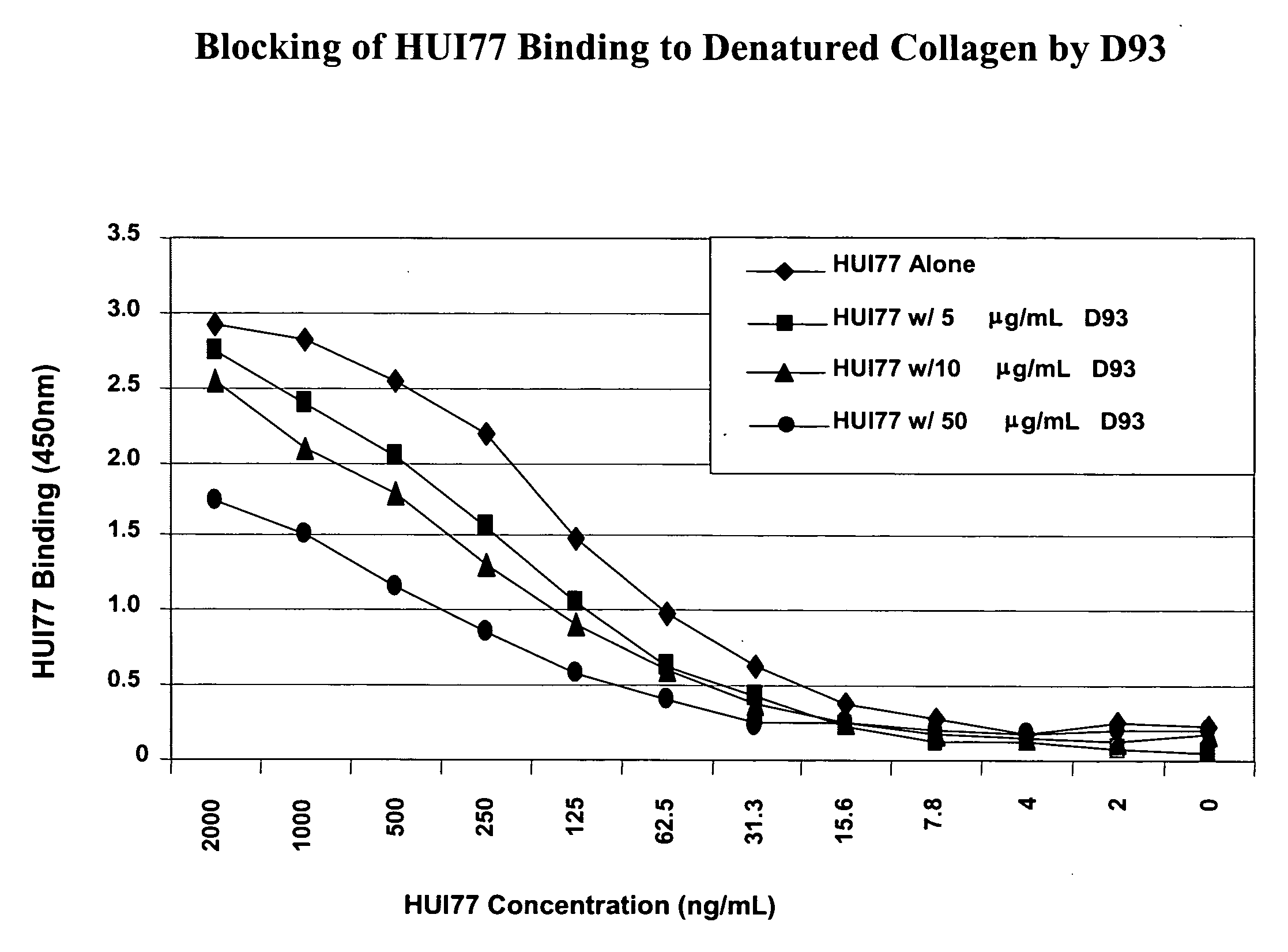Denatured collagen peptides and uses thereof
a collagen peptide and collagen technology, applied in the field of medicine, can solve the problems of differentially affecting invasive cellular behavior, limited success of these approaches, and large expansion of the limited view of the ecm, so as to reduce tumor size, prevent tumor progression, and reduce the effect of symptoms
- Summary
- Abstract
- Description
- Claims
- Application Information
AI Technical Summary
Benefits of technology
Problems solved by technology
Method used
Image
Examples
example 1
Monoclonal Antibody HUI77
[0595] This example describes the generation of a denatured collagen specific monoclonal antibody, Mab HUI77.
[0596] Mab HUI77 was generated and isolated by the immunological technique termed subtractive immunization (S.I). The subtractive immunization technique allows one to experimentally manipulate the immune response within mice to selectively enhance an immune response to a rare and / or low abundant epitope within a mixture of common highly antigenic epitopes. Briefly, female BALB / c mice were injected intraperitoneally with either native human triple helical collagen type-I or type-IV. At 24 and 48 hours following the injections of triple helical collagen, the mice were injected with the tolerizing agent cyclophosphamide to kill activated B-cells that would produce antibodies directed to common immunodominant epitopes within native triple helical collagen type-I and type-IV. Following the tolerization protocol, the mice were next injected with thermally...
example 2
Generation of CDR Variant Libraries of the HUI77 Antibody
[0600] This example describes the generation of CDR variant libraries of the HUI77 antibody for CDR optimization.
[0601] The CDR3 regions of antibodies HUI77 were optimized by generating a library of CDR variants. Primers for light chain CDR3 and heavy chain CDR3 were used to generate a library of CDR3 variants, where the primer was synthesized to encode more than one amino acid one or more positions in CDR3. Following synthesis of primers encoding CDR3 variants, the variant CDR3 regions were assembled into light chain (VL) and heavy chain (VH) regions.
[0602] Briefly, humanized VL and VH genes of HUI77 antibody were assembled with primers using PCR or primer-elongation-ligation as described in U.S. Ser. No. 10 / 011,529, which is incorporated herein in its entirety by reference. Variable region genes containing CDR3 mutations were assembled by replacing the wild type CDR3 primer (IV26-17, IV26-h7, I77-17 or I77-h7) with the gr...
example 3
Identification of Binding Sites on Denatured Collagen
[0608] Several binding sites for D93, a recombinant humanized IgG1 kappa antibody targeting denatured-collagen have been identified on collagen type IV. Proteolytic fragments of collagen IV were identified by Western blot analysis and subjected to protein sequencing by Edman degradation. Three peptides with an approximate size of 23, 35, and 57 kDa were shown to have N-terminal sequences consistent within the α1 chain of collagen type IV. Using D93 as a probe, a peptide with the sequence Hyp-G-A-K-G-L-P-G-P-Hyp-G-P-Hyp-G-P-Y (SEQ ID NO: 2) was identified by direct binding of a synthetic peptide array of the C-terminal region of the triple-helical region of collagen type IV (Hyp=hydroxyproline). Amino acids found to be important for maximum inhibition of D93 binding to denatured-collagen were identified as G-P-Hyp-G-P-Hyp-G-P-Y (SEQ ID NO: 30), with a strong dependence on the presence of hydroxyproline. The same peptide sequence w...
PUM
| Property | Measurement | Unit |
|---|---|---|
| time | aaaaa | aaaaa |
| time | aaaaa | aaaaa |
| time | aaaaa | aaaaa |
Abstract
Description
Claims
Application Information
 Login to View More
Login to View More - R&D
- Intellectual Property
- Life Sciences
- Materials
- Tech Scout
- Unparalleled Data Quality
- Higher Quality Content
- 60% Fewer Hallucinations
Browse by: Latest US Patents, China's latest patents, Technical Efficacy Thesaurus, Application Domain, Technology Topic, Popular Technical Reports.
© 2025 PatSnap. All rights reserved.Legal|Privacy policy|Modern Slavery Act Transparency Statement|Sitemap|About US| Contact US: help@patsnap.com



